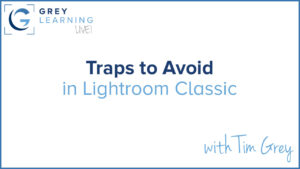

Today’s Question: I have about 220,000 images in my Lightroom Classic catalog. The previews file is getting quite large at over 1.1 TB. I’ve tried removing 1:1 previews but that did not decrease the size much. In a recent video you mentioned having over 400,000 images. How do you manage the size of the previews file?
Tim’s Quick Answer: You can manage the size of the previews file in Lightroom Classic by not building 1:1 previews if you don’t need them, configuring the preview settings so they don’t consume as much space, discarding previews for images you aren’t as likely to browse, and even discarding all previews and starting over with different settings and a more selective approach.
More Detail: The previews file associated with the catalog in Lightroom Classic contains standard (approximately display size) and 1:1 (full resolution) preview images for the photos in your catalog. This serves as a cache that improves performance when browsing your photos, but the previews file can also consumer considerable storage space.
First off, one thing to keep in mind is that it is possible to simply delete the Previews file (it has the same base filename as the catalog but with “Previews” appended to the name, and with a filename extension of .lrdata). Doing so will quickly free up considerable hard drive space, but of course it also means your browsing experience will be slower because previews will need to be built on the fly as you browse images for the first time. But this can be a great way to do a bit of a reset, especially if you have the time to let Lightroom Classic build previews for your most important photos.
Also, you can configure the previews so they consume less space. Changing the settings combined with discarding the previews enables you to clear up the space and then not consume as much space moving forward. In the Catalog Settings dialog you can specify how long 1:1 previews are preserved. On the Previews tab you can set the “Automatically Discard 1:1 Previews” popup to “After One Day” or “After One Week”, rather than the default of “After 30 Days”. Note that 1:1 previews are only needed when you zoom into an image, but not in the Develop module where the preview is based on the source image rather than the previews cache.
You can also adjust the size and quality for standard previews in the Catalog Settings dialog. I recommend choosing the size option from the “Standard Preview Size” popup that is closest to the horizontal pixel dimension for your monitor display. This is based on the setting you’re using in your operating system, not the physical resolution of your display. For example, if you’re using a 4K display set to 1920×1080 resolution, I recommend using the “2048 pixels” option rather than Auto, as the latter would cause larger previews than are necessary to be built. You can also choose Low rather than Medium from the “Preview Quality” popup if you want to further reduce the space required for previews at the expense of preview quality.
In addition to the above, you can choose to discard previews for selected photos. This could be helpful if, for example, you store key photos on one hard drive and less important photos on another drive. You could select all photos on the less important drive and from the menu choose Library > Previews, then select “Discard 1:1 Previews” if you only want to discard the larger 1:1 previews, or “Discard Standard and 1:1 Previews (which is a relatively new command) if you want to discard all previews for the selected images.
Note that if you have discarded all previews, for example, you can then select photos you want to be able to browse more quickly, and then build previews for them by choosing Library > Previews > Build Standard Previews from the menu. This process can take a bit of time depending on how many photos you’ve selected, but after that process is complete your browsing experience will be much faster for the photos you’ve built previews for.



